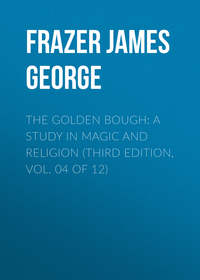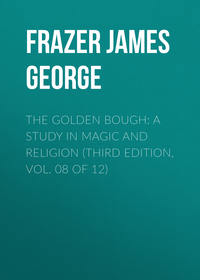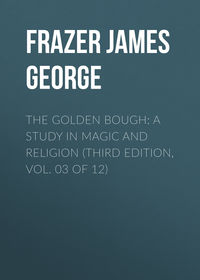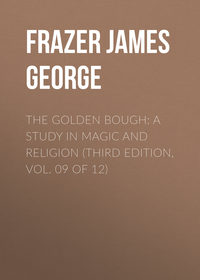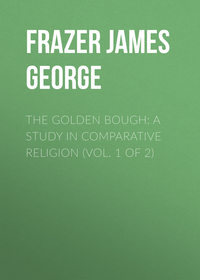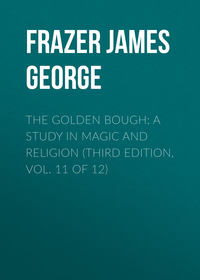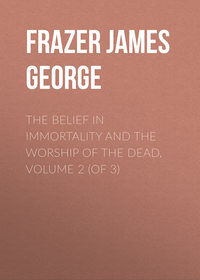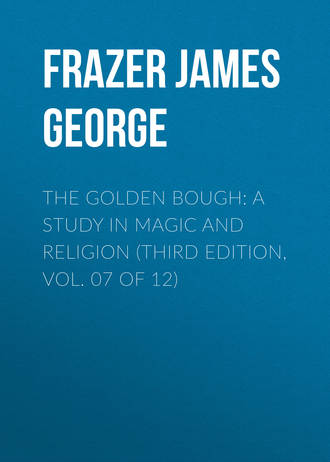 полная версия
полная версияThe Golden Bough: A Study in Magic and Religion (Third Edition, Vol. 07 of 12)
The Old Woman (the Baba) at harvest in Lithuania.
In Lithuania the name for the last sheaf is Boba (Old Woman), answering to the Polish name Baba. The Boba is said to sit in the corn which is left standing last.483 The person who binds the last sheaf or digs the last potato is the subject of much banter, and receives and long retains the name of the Old Rye-woman or the Old Potato-woman.484 The last sheaf – the Boba – is made into the form of a woman, carried solemnly through the village on the last harvest-waggon, and drenched with water at the farmer's house; then every one dances with it.485
The Corn-queen and the Harvest-queen.
In Russia also the last sheaf is often shaped and dressed as a woman, and carried with dance and song to the farmhouse. Out of the last sheaf the Bulgarians make a doll which they call the Corn-queen or Corn-mother; it is dressed in a woman's shirt, carried round the village, and then thrown into the river in order to secure plenty of rain and dew for the next year's crop. Or it is burned and the ashes strewn on the fields, doubtless to fertilise them.486 The name Queen, as applied to the last sheaf, has its analogies in central and northern Europe. Thus, in the Salzburg district of Austria, at the end of the harvest a great procession takes place, in which a Queen of the Corn-ears (Ährenkönigin) is drawn along in a little carriage by young fellows.487 The custom of the Harvest Queen appears to have been common in England. Brand quotes from Hutchinson's History of Northumberland the following: “I have seen, in some places, an image apparelled in great finery, crowned with flowers, a sheaf of corn placed under her arm, and a scycle in her hand, carried out of the village in the morning of the conclusive reaping day, with music and much clamour of the reapers, into the field, where it stands fixed on a pole all day, and when the reaping is done, is brought home in like manner. This they call the Harvest Queen, and it represents the Roman Ceres.”488 Again, the traveller Dr. E. D. Clarke tells us that “even in the town of Cambridge, and centre of our University, such curious remains of antient customs may be noticed, in different seasons of the year, which pass without observation. The custom of blowing horns upon the first of May (Old Style) is derived from a festival in honour of Diana. At the Hawkie, as it is called, or Harvest Home, I have seen a clown dressed in woman's clothes, having his face painted, his head decorated with ears of corn, and bearing about him other symbols of Ceres, carried in a waggon, with great pomp and loud shouts, through the streets, the horses being covered with white sheets: and when I inquired the meaning of the ceremony, was answered by the people that they were drawing the Morgay (ΜΗΤΗΡ ΓΗ) or Harvest Queen.”489 Milton must have been familiar with the custom of the Harvest Queen, for in Paradise Lost490 he says: —
“Adam the whileWaiting desirous her return, had woveOf choicest flow'rs a garland to adornHer tresses, and her rural labours crown,As reapers oft are wont their harvest-queen.”The corn-spirit as the Old Woman or Old Man at threshing.
Often customs of this sort are practised, not on the harvest-field but on the threshing-floor. The spirit of the corn, fleeing before the reapers as they cut down the ripe grain, quits the reaped corn and takes refuge in the barn, where it appears in the last sheaf threshed, either to perish under the blows of the flail or to flee thence to the still unthreshed corn of a neighbouring farm.491 Thus the last corn to be threshed is called the Mother-Corn or the Old Woman. Sometimes the person who gives the last stroke with the flail is called the Old Woman, and is wrapt in the straw of the last sheaf, or has a bundle of straw fastened on his back. Whether wrapt in the straw or carrying it on his back, he is carted through the village amid general laughter. In some districts of Bavaria, Thüringen, and elsewhere, the man who threshes the last sheaf is said to have the Old Woman or the Old Corn-woman; he is tied up in straw, carried or carted about the village, and set down at last on the dunghill, or taken to the threshing-floor of a neighbouring farmer who has not finished his threshing.492 In Poland the man who gives the last stroke at threshing is called Baba (Old Woman); he is wrapt in corn and wheeled through the village.493 Sometimes in Lithuania the last sheaf is not threshed, but is fashioned into female shape and carried to the barn of a neighbour who has not finished his threshing.494
The man who gives the last stroke at threshing is called the Corn-fool, the Oats-fool, etc.
At Chorinchen, near Neustadt, the man who gives the last stroke at threshing is said to “get the Old Man.”495 In various parts of Austrian Silesia he is called the corn-fool, the oats-fool, and so forth according to the crop, and retains the name till the next kind of grain has been reaped. Sometimes he is called the Klöppel or mallet. He is much ridiculed and in the Bennisch district he is dressed out in the threshing-implements and obliged to carry them about the farmyard to the amusement of his fellows. In Dobischwald the man who gives the last stroke at threshing has to carry a log or puppet of wood wrapt in straw to a neighbour who has not yet finished his threshing. There he throws his burden into the barn, crying, “There you have the Mallet (Klöppel),” and makes off as fast as he can. If they catch him, they tie the puppet on his back, and he is known as the Mallet (Klöppel) for the whole of the year; he may be the Corn-mallet or the Wheat-mallet or so forth according to the particular crop.496
The man who gives the last stroke at threshing is said to get the Old Woman or the Old Man. The Corn-woman at threshing.
About Berneck, in Upper Franken, the man who gives the last stroke at threshing runs away. If the others catch him, he gets “the Old Woman,” that is, the largest dumpling, which elsewhere is baked in human shape. The custom of setting a dumpling baked in the form of an old woman before the man who has given the last stroke at threshing is also observed in various parts of Middle Franken. Sometimes the excised genitals of a calf are served up to him at table.497 At Langenbielau in Silesia the last sheaf, which is called “the Old Man,” is threshed separately and the corn ground into meal and baked into a loaf. This loaf is believed to possess healing virtue and to bring a blessing; hence none but members of the family may partake of it. At Wittichenau, in the district of Hoyerswerda (Silesia), when the threshing is ended, some of the straw of “the Old Man” is carried to a neighbour who has not yet finished his threshing, and the bearer is rewarded with a gratuity.498 Among the Germans of the Falkenauer district in West Bohemia the man who gives the last stroke at threshing gets “the Old Man,” a hideous scarecrow, tied on his back. If threshing is still proceeding at another farm, he may go thither and rid himself of his burden, but must take care not to be caught. In this way a farmer who is behind-hand with his threshing may receive several such scarecrows, and so become the target for many gibes. Among the Germans of the Planer district in West Bohemia, the man who gives the last stroke at threshing is himself called “the Old Man.” Similarly at flax-dressing in Silberberg (West Bohemia), the woman who is the last to finish her task is said to get the Old Man, and a cake baked in human form is served up to her at supper.499 The Wends of Saxony say of the man who gives the last stroke at threshing that “he has struck the Old Man” (wón je stareho bil), and he is obliged to carry a straw puppet to a neighbour, who has not yet finished his threshing, where he throws the puppet unobserved over the fence.500 In some parts of Sweden, when a stranger woman appears on the threshing-floor, a flail is put round her body, stalks of corn are wound round her neck, a crown of ears is placed on her head, and the threshers call out, “Behold the Corn-woman.” Here the stranger woman, thus suddenly appearing, is taken to be the corn-spirit who has just been expelled by the flails from the corn-stalks.501 In other cases the farmer's wife represents the corn-spirit. Thus in the Commune of Saligné, Canton de Poiret (Vendée), the farmer's wife, along with the last sheaf, is tied up in a sheet, placed on a litter, and carried to the threshing machine, under which she is shoved. Then the woman is drawn out and the sheaf is threshed by itself, but the woman is tossed in the sheet, as if she were being winnowed.502 It would be impossible to express more clearly the identification of the woman with the corn than by this graphic imitation of threshing and winnowing her. Mitigated forms of the custom are observed in various places. Thus among the Germans of Schüttarschen in West Bohemia it was customary at the close of the threshing to “throttle” the farmer's wife by squeezing her neck between the arms of a flail till she consented to bake a special kind of cake called a drischala (from dreschen, “to thresh”).503 A similar custom of “throttling” the farmer's wife at the threshing is practised in some parts of Bavaria, only there the pressure is applied by means of a straw rope instead of a flail.504
The corn-spirit as a child at harvest.
In these customs the spirit of the ripe corn is regarded as old, or at least as of mature age. Hence the names of Mother, Grandmother, Old Woman, and so forth. But in other cases the corn-spirit is conceived as young. Thus at Saldern, near Wolfenbuttel, when the rye has been reaped, three sheaves are tied together with a rope so as to make a puppet with the corn ears for a head. This puppet is called the Maiden or the Corn-maiden (Kornjungfer).505 Sometimes the corn-spirit is conceived as a child who is separated from its mother by the stroke of the sickle. This last view appears in the Polish custom of calling out to the man who cuts the last handful of corn, “You have cut the navel-string.”506 In some districts of West Prussia the figure made out of the last sheaf is called the Bastard, and a boy is wrapt up in it. The woman who binds the last sheaf and represents the Corn-mother is told that she is about to be brought to bed; she cries like a woman in travail, and an old woman in the character of grandmother acts as midwife. At last a cry is raised that the child is born; whereupon the boy who is tied up in the sheaf whimpers and squalls like an infant. The grandmother wraps a sack, in imitation of swaddling bands, round the pretended baby, who is carried joyfully to the barn, lest he should catch cold in the open air.507 In other parts of North Germany the last sheaf, or the puppet made out of it, is called the Child, the Harvest-Child, and so on, and they call out to the woman who binds the last sheaf, “you are getting the child.”508
The last corn cut called the mell, the kirn, or the churnin various parts of England. The churncut by throwing sickles at it.
In the north of England, particularly in the counties of Northumberland, Durham, and Yorkshire, the last corn cut on the field at harvest is or used to be variously known as the mell or the kirn, of which kern and churn are merely local or dialectical variations. The corn so cut is either plaited or made up into a doll-like figure, which goes by the name of the mell-doll or the kirn-doll, or the kirn-baby, and is brought home with rejoicings at the end of the harvest.509 In the North Riding of Yorkshire the last sheaf gathered in is called the Mell-sheaf, and the expression “We've gotten wer mell” is as much as to say “The Harvest is finished.” Formerly a Mell-doll was made out of a sheaf of corn decked with flowers and wrapped in such of the reapers' garments as could be spared. It was carried with music and dancing to the scene of the harvest-supper, which was called the mell-supper.510 In the north of Yorkshire the mell-sheaf “was frequently made of such dimensions as to be a heavy load for a man, and, within a few years comparatively, was proposed as the prize to be won in a race of old women. In other cases it was carefully preserved and set up in some conspicuous place in the farmhouse.”511 Where the last sheaf of corn cut was called the kirn or kern instead of the mell, the customs concerned with it seem to have been essentially similar. Thus we are told that in the north it was common for the reapers, on the last day of the reaping, “to have a contention for superiority in quickness of dispatch, groups of three or four taking each a ridge, and striving which should soonest get to its termination. In Scotland, this was called a kemping, which simply means a striving. In the north of England, it was a mell… As the reapers went on during the last day, they took care to leave a good handful of the grain uncut, but laid down flat, and covered over; and, when the field was done, the ‘bonniest lass’ was allowed to cut this final handful, which was presently dressed up with various sewings, tyings, and trimmings, like a doll, and hailed as a Corn Baby. It was brought home in triumph, with music of fiddles and bagpipes, was set up conspicuously that night at supper, and was usually preserved in the farmer's parlour for the remainder of the year. The bonny lass who cut this handful of grain was deemed the Har'st Queen”.512 To cut the last portion of standing corn in the harvest field was known as “to get the kirn” or “to win the kirn”; and as soon as this was done the reapers let the neighbours know that the harvest was finished by giving three cheers, which was called “to cry or shout the kirn.”513 Where the last handful of standing corn was called the churn, the stalks were roughly plaited together, and the reapers threw their sickles at it till some one cut it through, which was called “cutting the churn.” The severed churn (that is, the plaited corn) was then placed over the kitchen door or over the hob in the chimney for good luck, and as a charm against witchcraft.514 In Kent the Ivy Girl is, or used to be, “a figure composed of some of the best corn the field produces, and made as well as they can into a human shape; this is afterwards curiously dressed by the women, and adorned with paper trimmings, cut to resemble a cap, ruffles, handkerchief, etc., of the finest lace. It is brought home with the last load of corn from the field upon the waggon, and they suppose entitles them to a supper at the expense of the employer.”515
The last corn cut called the kirn in some parts of Scotland. The kirncut by reapers blindfold.
In some parts of Scotland, as well as in the north of England, the last handful of corn cut on the harvest-field was called the kirn, and the person who carried it off was said “to win the kirn.” It was then dressed up like a child's doll and went by the name of the kirn-baby, the kirn-doll, or the Maiden.516 In Berwickshire down to about the middle of the nineteenth century there was an eager competition among the reapers to cut the last bunch of standing corn. They gathered round it at a little distance and threw their sickles in turn at it, and the man who succeeded in cutting it through gave it to the girl he preferred. She made the corn so cut into a kirn-dolly and dressed it, and the doll was then taken to the farmhouse and hung up there till the next harvest, when its place was taken by the new kirn-dolly.517 At Spottiswoode (Westruther Parish) in Berwickshire the reaping of the last corn at harvest was called “cutting the Queen” almost as often as “cutting the kirn.” The mode of cutting it was not by throwing sickles. One of the reapers consented to be blindfolded, and having been given a sickle in his hand and turned twice or thrice about by his fellows, he was bidden to go and cut the kirn. His groping about and making wild strokes in the air with his sickle excited much hilarity. When he had tired himself out in vain and given up the task as hopeless, another reaper was blindfolded and pursued the quest, and so on, one after the other, till at last the kirn was cut. The successful reaper was tossed up in the air with three cheers by his brother harvesters. To decorate the room in which the kirn-supper was held at Spottiswoode as well as the granary, where the dancing took place, two women made kirn-dollies or Queens every year; and many of these rustic effigies of the corn-spirit might be seen hanging up together.518 At Lanfine in Ayrshire, down to near the end of the nineteenth century, the last bunch of standing corn at harvest was, occasionally at least, plaited together, and the reapers tried to cut it by throwing their sickles at it; when they failed in the attempt, a woman has been known to run in and sever the stalks at a blow. In Dumfriesshire also, within living memory, it used to be customary to cut the last standing corn by throwing the sickles at it.519
The churnin Ireland cut by throwing the sickles at it.
In the north of Ireland the harvest customs were similar, but there, as in some parts of England, the last patch of standing corn bore the name of the churn, a dialectical variation of kirn. “The custom of ‘Winning the Churn’ was prevalent all through the counties of Down and Antrim fifty years ago. It was carried out at the end of the harvest, or reaping the grain, on each farm or holding, were it small or large. Oats are the main crop of the district, but the custom was the same for other kinds of grain. When the reapers had nearly finished the last field a handful of the best-grown stalks was selected, carefully plaited as it stood, and fastened at the top just under the ears to keep the plait in place. Then when all the corn was cut from about this, which was known as The Churn, and the sheaves about it had been removed to some distance, the reapers stood in a group about ten yards off it, and each whirled his sickle at the Churn till one lucky one succeeded in cutting it down, when he was cheered on his achievement. This person had then the right of presenting it to the master or mistress of the farm, who gave the reaper a shilling.” A supper and a dance of the reapers in the farmhouse often concluded the day. The Churn, trimmed and adorned with ribbons, was hung up on a wall in the farmhouse and carefully preserved. It was no uncommon sight to see six or even twelve or more such Churns decorating the walls of a farmhouse in County Down or Antrim.520
The last corn cut called the Maiden in the Highlands of Scotland.
In some parts of the Highlands of Scotland the last handful of corn that is cut by the reapers on any particular farm is called the Maiden, or in Gaelic Maidhdeanbuain, literally “the shorn Maiden.” Superstitions attach to the winning of the Maiden. If it is got by a young person, they think it an omen that he or she will be married before another harvest. For that or other reasons there is a strife between the reapers as to who shall get the Maiden, and they resort to various stratagems for the purpose of securing it. One of them, for example, will often leave a handful of corn uncut and cover it up with earth to hide it from the other reapers, till all the rest of the corn on the field is cut down. Several may try to play the same trick, and the one who is coolest and holds out longest obtains the coveted distinction. When it has been cut, the Maiden is dressed with ribbons into a sort of doll and affixed to a wall of the farmhouse. In the north of Scotland the Maiden is carefully preserved till Yule morning, when it is divided among the cattle "to make them thrive all the year round."521 In the island of Mull and some parts of the mainland of Argyleshire the last handful of corn cut is called the Maiden (Maighdean-Bhuana). Near Ardrishaig, in Argyleshire, the Maiden is made up in a fanciful three-cornered shape, decorated with ribbons, and hung from a nail on the wall.522
The cutting of the Maiden at harvest in Argyleshire.
The following account of the Maiden was obtained in the summer of 1897 from the manager of a farm near Kilmartin in Argyleshire: “The Mhaighdean-Bhuana, or Reaping Maiden, was the last sheaf of oats to be cut on a croft or farm. Before the reaping-machine and binder took the place of the sickle and the scythe, the young reapers of both sexes, when they neared the end of the last rig or field, used to manœuvre to gain possession of the Mhaighdean-Bhuana. The individual who was fortunate enough to obtain it was ex officio entitled to be the King or the Queen of the Harvest-Home festival. The sheaf so designated was carefully preserved and kept intact until the day they began leading home the corn. A tuft of it was then given to each of the horses, as they started from the corn-field with their first load. The rest of it was neatly made up, and hung in some conspicuous corner of the farmhouse, where it remained till it was replaced by a younger sister next season. On the first day of ploughing a tuft of it was given (as on the first day of leading home the corn) as a Sainnseal or handsel for luck to the horses. The Mhaighdean-Bhuana so preserved and used was a symbol that the harvest had been duly secured, and that the spring work had been properly inaugurated. It was also believed to be a protection against fairies and witchcraft.”523
The cutting of the Maiden at harvest in Perthshire.
In the parish of Longforgan, situated at the south-eastern corner of Perthshire, it used to be customary to give what was called the Maiden Feast at the end of the harvest. The last handful of corn reaped on the field was called the Maiden, and things were generally so arranged that it fell into the hands of a pretty girl. It was then decked out with ribbons and brought home in triumph to the music of bagpipes and fiddles. In the evening the reapers danced and made merry. Afterwards the Maiden was dressed out, generally in the form of a cross, and hung up, with the date attached to it, in a conspicuous part of the house.524 In the neighbourhood of Balquhidder, Perthshire, the last handful of corn is cut by the youngest girl on the field, and is made into the rude form of a female doll, clad in a paper dress, and decked with ribbons. It is called the Maiden, and is kept in the farmhouse, generally above the chimney, for a good while, sometimes till the Maiden of the next year is brought in. The writer of this book witnessed the ceremony of cutting the Maiden at Balquhidder in September 1888.525 A lady friend526 informed me that as a young girl she cut the Maiden several times at the request of the reapers in the neighbourhood of Perth. The name of the Maiden was given to the last handful of standing corn; a reaper held the top of the bunch while she cut it. Afterwards the bunch was plaited, decked with ribbons, and hung up in a conspicuous place on the wall of the kitchen till the next Maiden was brought in. The harvest-supper in this neighbourhood was also called the Maiden; the reapers danced at it.
The Maiden at harvest in Lochaber. The cutting of the Maiden at harvest on the Gareloch in Dumbartonshire.
In the Highland district of Lochaber dancing and merry-making on the last night of harvest used to be universal and are still generally observed. Here, we are told, the festivity without the Maiden would be like a wedding without the bride. The Maiden is carried home with tumultuous rejoicing, and after being suitably decorated is hung up in the barn, where the dancing usually takes place. When supper is over, one of the company, generally the oldest man present, drinks a glass of whisky, after turning to the suspended sheaf and saying, “Here's to the Maiden.” The company follow his example, each in turn drinking to the Maiden. Then the dancing begins.527 On some farms on the Gareloch, in Dumbartonshire, about the year 1830, the last handful of standing corn was called the Maiden. It was divided in two, plaited, and then cut with the sickle by a girl, who, it was thought, would be lucky and would soon be married. When it was cut the reapers gathered together and threw their sickles in the air. The Maiden was dressed with ribbons and hung in the kitchen near the roof, where it was kept for several years with the date attached. Sometimes five or six Maidens might be seen hanging at once on hooks. The harvest-supper was called the Kirn.528 In other farms on the Gareloch the last handful of corn was called the Maidenhead or the Head; it was neatly plaited, sometimes decked with ribbons, and hung in the kitchen for a year, when the grain was given to the poultry.529


